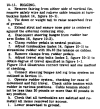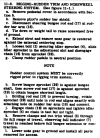Question for the more experienced pilots in the group.
I went up for a flight in the left seat this past weekend for the first time in over 24 years and although the instructor was impressed with what I remembered, I had one hell of a time with the take off and landings. Of the 4 we did, 3 of the landings were flat and all the take offs were like doing a vertical climb like a military jet,
Both the landings and take offs required what I felt like were way way to much back pressure on the yoke.
The take offs were like the aircraft was glued to the runway and once it lifted off it was like a high speed climb.
The landings were kind of the opposite I would pull back pull back and land on all three wheels. The 4th and final landing of the day, I pulled through what I describe as a stop in the travel and we managed to land correctly on the mains but ended up ballooning some before touching back down again.
I don't remember C172s having what i describe as a stop in the yoke travel? The three other C172's I've flown from the left seat were all smooth in their travel and I never had trouble with take offs or landings. I didn't notice this 'stop' in the preflight check either.
This organization has a second C172N that I can try, but before I go that way I wanted to post here and see if others have an idea what to look for.
Mark
PS I might just have the instructor do a TO & Landing on the next lesson so that I can watch him at the controls. (Yes my first lesson in 24 years I was at the controls fully the minute the engine started LOL)
I went up for a flight in the left seat this past weekend for the first time in over 24 years and although the instructor was impressed with what I remembered, I had one hell of a time with the take off and landings. Of the 4 we did, 3 of the landings were flat and all the take offs were like doing a vertical climb like a military jet,
Both the landings and take offs required what I felt like were way way to much back pressure on the yoke.
The take offs were like the aircraft was glued to the runway and once it lifted off it was like a high speed climb.
The landings were kind of the opposite I would pull back pull back and land on all three wheels. The 4th and final landing of the day, I pulled through what I describe as a stop in the travel and we managed to land correctly on the mains but ended up ballooning some before touching back down again.
I don't remember C172s having what i describe as a stop in the yoke travel? The three other C172's I've flown from the left seat were all smooth in their travel and I never had trouble with take offs or landings. I didn't notice this 'stop' in the preflight check either.
This organization has a second C172N that I can try, but before I go that way I wanted to post here and see if others have an idea what to look for.
Mark
PS I might just have the instructor do a TO & Landing on the next lesson so that I can watch him at the controls. (Yes my first lesson in 24 years I was at the controls fully the minute the engine started LOL)



